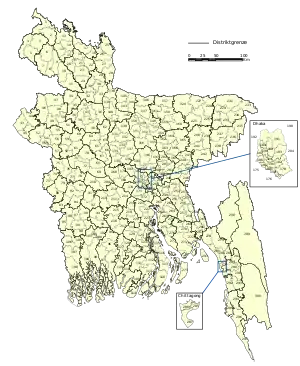Next Bangladeshi general election
General elections are scheduled to be held in Bangladesh by December 2023.[1][2]
| |||||||||||||||||||||||||
All 300 directly elected seats in the Jatiya Sangsad 151 seats needed for a majority | |||||||||||||||||||||||||
|---|---|---|---|---|---|---|---|---|---|---|---|---|---|---|---|---|---|---|---|---|---|---|---|---|---|
| |||||||||||||||||||||||||
 | |||||||||||||||||||||||||
| |||||||||||||||||||||||||
Background
The Awami League won the 2018 general elections and formed the government.[3] The tenure of the government lasts five years.[4] Incumbent Prime Minister Sheikh Hasina has hinted she does not intend to lead her party, the Awami League, into another election.[5]
Electoral system
The 350 members of the Jatiya Sangsad consist of 300 directly elected seats using first-past-the-post voting in single-member constituencies, and an additional 50 seats reserved for women. The reserved seats are elected proportionally by the elected members. Each parliament sits for a five-year term.[6]
References
- Malhotra, Jyoti (2019-01-02). "Why India supports the invincible Sheikh Hasina—who is censoring democracy in Bangladesh". ThePrint. Retrieved 2021-04-18.
- "5G by 2023 if AL voted to power". The Daily Star. 2018-12-18. Retrieved 2021-04-18.
- "Get 11th Bangladesh National Election 2018 Results". The Daily Star. 2018-11-14. Retrieved 2021-04-18.
- "Jatiya Sangsad - Banglapedia". en.banglapedia.org. Retrieved 2021-04-18.
- "Bangladesh PM Sheikh Hasina hints at last term as prime minister". DW. Retrieved 2021-05-31.
- "IPU PARLINE database: BANGLADESH (Jatiya Sangsad), Electoral system". archive.ipu.org. Retrieved 2021-04-18.
This article is issued from Wikipedia. The text is licensed under Creative Commons - Attribution - Sharealike. Additional terms may apply for the media files.
_(cropped).jpg.webp)

